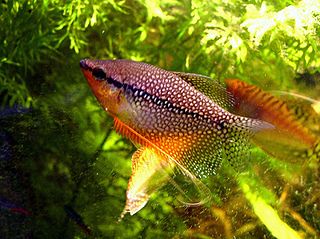
The pearl gourami is a species of gourami native to Southeast Asia.

The spectacled triplefin is a triplefin in the genus Ruanoho. It is commonly found around New Zealand from depths of a few metres to about 30 m, most common in reef areas of broken rock. Its length is between 4 and 8 cm and its head is flattened with large eyes surrounded by a dark band giving rise to its common name. The head and fins have a pattern of fine blue lines. Its large pectoral fins are used as props when resting on the bottom where it spends most of its time.
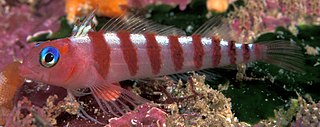
The blue-eyed triplefin is a fish in the genus Notoclinops, commonly found around the North Island of New Zealand from depths of a metre to about 30 m, most common in reef areas of broken rock. Its length is between 3 and 6 cm and it is easily distinguished from other small fish by its iridescent blue eyes which give its name. There are nine red vertical bars running right round the body, and an orange tinge to the back and head.
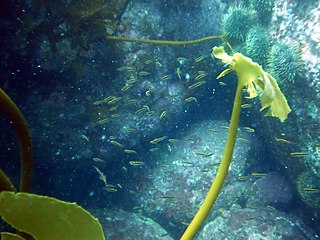
The oblique-swimming triplefin is a triplefin, found along the north east coast of the North Island of New Zealand from depths of about 5 m to 50 m. They are the only triplefins not to spend most of their time resting on the bottom, instead swimming in loose schools of up to hundreds of individuals above rocky reefs. When swimming their head is higher than the tail, giving rise to their common name.

The blue dot triplefin is a fish in the genus Notoclinops, found around offshore islands and exposed headlands of the eastern side of Northland, and the Bay of Plenty, on the North Island of New Zealand from depths of a metre or so to about 30 m, most common in reef areas of broken rock. Its length is only up to about 5 cm and it is the smallest of the triplefins in New Zealand.

The scaly-headed triplefin, Karalepis stewarti, is a triplefin, the only species in the genus Karalepis. It is endemic to New Zealand where it is found around North Island, South Island, the Three Kings Islands, Snares Island and Stewart Island. It is a nocturnal species It occurs at depths of about 5 to 30 metres, in reef areas of broken rock. The specific name honours Andy Stewart of the Department of Fishes at the National Museum of New Zealand.
The mottled triplefin is a triplefin of the genus Forsterygion, found around New Zealand at depths down to 30 m, in reef areas of broken rock. Its specific name honours Malcolm Francis of the Fisheries Research Centre in Wellington, New Zealand, who joined Hardy on his trips to collect specimens.
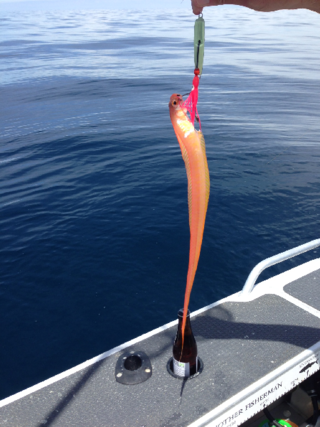
Cepola haastii is a species of marine ray-finned fish belonging to the family Cepolidae, the bandfishes. It is found on the inner continental shelf around New Zealand. Its length is between 15 and 25 cm. This species is known as the red bandfish, a name given to most of the other members of the genus Cepola, especially the European species, Cepola macrophthalma.

Allard's clownfish or Allard's anemonefish is a marine fish belonging to the family Pomacentridae, the clownfishes and damselfishes, from the western Indian Ocean off the coast of East Africa and the Mascarenes.

Rendahl's messmate is a pearlfish of the family Carapidae, found in the southwest Pacific Ocean around Australia and New Zealand at depths to 60 metres (200 ft). Its length is between 10 and 12 centimetres .The larvae has a long filament on its head which bears some resemblance to a siphonophore. These fish live within sponges. The specific name honours the Swedish naturalist and artist Hialmar Rendahl who collected the specimens in the Tasman Sea which were used by Gilbert Percy Whitley to describe this species.

The southern conger is a conger of the family Congridae, found in the eastern Indian Ocean and south-western Pacific Ocean, including southern Australia and New Zealand, at depths down to 100 m in broken rocky reef areas. Length is up to 2 m and weight may be up to 5 kg.

Helicolenus percoides, the reef ocean perch, coral cod, coral perch, Jock Stewart, kuriarki, ocean perch, red gurnard perch, red gurnard scorpionfish, red ocean perch, red perch, red rock perch, scarpee or sea perch, is a species of marine ray-finned fish belonging to the subfamily Sebastinae, part of the family Scorpaenidae. It is found in the southwestern Pacific Ocean.

The yellowspotted sawtail, or spotted sawtail, is a species of marine ray-finned fish belonging to the family Acanthuridae, the surgeonfishes, unicornfishes and tangs. This fish is found in the southwest Pacific Ocean.

Bellapiscis lesleyae, the mottled twister, is a triplefin of the family Tripterygiidae, commonly found around the coast of New Zealand in rock pools and down to depths of about 5 m in reef areas of broken rock. Its length is up to 6 cm. The specific name of this blenny honours the New Zealand marine biologist Lesley Bolton who helped Hardy collect fishes in rockpools on the coast of New Zealand, including the type of this species.

The cryptic triplefin, Cryptichthys jojettae, is a triplefin of the family Tripterygiidae, the only member of the genus Cryptichthys, found around the coast of New Zealand. It length is up to 6 cm. The specific name honours a former staff member at the National Museum of New Zealand, Jorjette Drost, who participated in collecting specimens with Hardy.

The French angelfish is a species of marine ray-finned fish, a marine angelfish belonging to the family Pomacanthidae. It occurs in the Western Atlantic Ocean.

Notoclinops is the name of a genus of triplefins in the family Tripterygiidae from New Zealand.

Apolemichthys xanthurus, the Indian yellowtail angelfish, is a species of marine angelfish belonging to the family Pomacanthidae. Other common names include cream angelfish, smoke angelfish, and yellowtail black angelfish. It is found in the Indian Ocean.

Paranotothenia magellanica, also known as Magellanic rockcod, Maori cod, blue notothenia or orange throat notothen, is a species of marine ray-finned fish, belonging to the family Nototheniidae, the notothens or cod icefishes. It is native to the Southern Ocean. "Maori chief" and "black cod", sometimes used for this species, usually refer to fishes from the related genus Notothenia. Being a perciform fish, it is unrelated to the true cods of the order Gadiformes. This species is commercially important as a food fish.
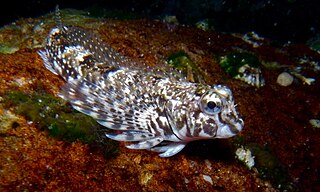
The eastern jumping blenny is a species of triplefin blenny in the genus Lepidoblennius. It was described by Franz Steindachner in 1867 and is the type species of the genus Lepidoblennius.



















